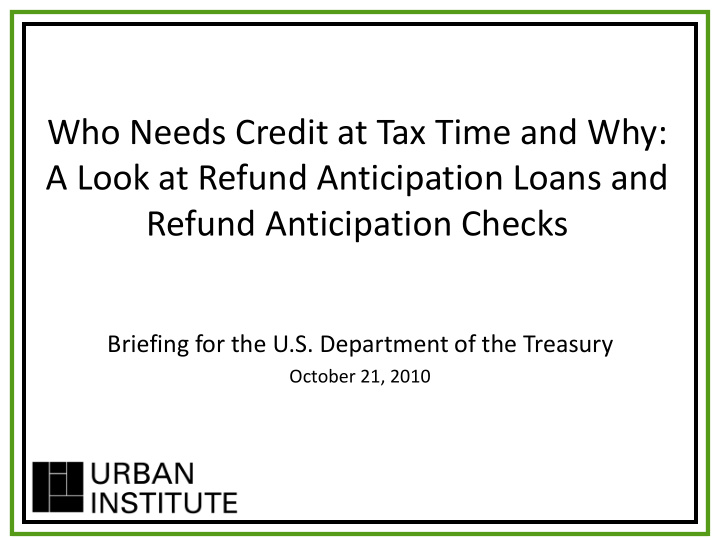



Who Needs Credit at Tax Time and Why: A Look at Refund Anticipation Loans and Refund Anticipation Checks Briefing for the U.S. Department of the Treasury October 21, 2010
The Products Refund Anticipation Loan Refund Anticipation Check (RAL) (RAC) • Bank opens temporary • Interest-bearing loan account where tax refund secured by taxpayers’ is directly deposited expected tax refund • Consumer issued a paper • Loans made by banks check or debit card after facilitated by tax refund arrives preparers and software • For tax filers with bank • Loans received within 1-3 accounts, no quicker than days other IRS direct deposit 2 2
Product Fees and Profits • Pricing varies and fees are ‘unbundled’ • Flat fee to set up account (typically $30-$35) • RAL loan fee (typically 1% of loan) • Document processing and other added fees • RALs typically range from $62 to $117; RACs typically cost $57 • Consumers paid approximately $833 million in RAL fees in 2006 and $740 million in 2007 1 • As RAL fees have declined, tax preparation fees have increased 2 1 Wu and Fox (2010). 3 3 2 Holt (2009).
Study Questions • Who uses RALs and RACs? • Demographic, economic, and geographic characteristics associated with take-up • Why do RALs and RACs exist? • Taxpayer motivations • Role of tax preparers 4 4
Data and Methods • IRS data from tax years 2005 through 2008 • Descriptive analyses on the universe of tax filers 18 years or older with refunds ~111mil filers in TY 2008 • Multinomial logistic regressions using 1% sample of US taxpayers in TY2005 and TY 2008 • Secondary data about the communities where taxpayers live • 18 interviews with 11 organizations • Tax preparers, RAL/RAC lenders, RAL/RAC transmitters, Low-cost RAL lenders, VITA program sites 5
RAL/RAC Use Over Time 6 6 Sources: Wu 2005, GAO 2009, Wu and Fox 2010, and authors ’ analysis of IRS data.
RAL/RAC Returns Filed Early RAL Cumulative RAC Cumulative Non-RAL/ RAC Cumulative 100% 90% 80% 70% 60% 50% 40% 30% 20% 10% 0% Date of Tax Filing*, Calendar Year 2009 (TY2008)
EITC and Children Matter • 64% of RALs and 42% of RACs are taken out by EITC claimants with qualifying children • EITC claimants with qualifying children are 126% more likely to take out a RAL than non-EITC claimants • Complicated tax forms and EITC instructions may be driver 8 8
HOH Filers are Highest RAL/RAC Users 9 9
Greatest Use In Early Career/Family Years
RAL Use Down Among Military Hhlds 11
Being ‘Banked’ Matters 12 12
RAL/RAC Use Highest in Low-inc Communities 13
14
RAL & RAC Use in Washington (District of RAL & RAC Use in St. Louis (Missouri) Columbia) Metropolitan Area, TY 2008 Metropolitan Area, TY 2008 0 5 10 20 Miles 0 5 10 20 Miles 15
RAL & RAC Use in Chicago RAL & RAC Use in Memphis (Tennessee) (Illinois) Metropolitan Area, TY 2008 Metropolitan Area, TY 2008 0 5 10 20 Miles 0 4 8 16 Miles 16
Consumer Motivations • Quick money to alleviate post-holiday financial strain • General financial strain and unexpected expenses • Lack of funds to pay for tax preparation costs • Lack of a bank account • Complexity of tax returns • Mistrust of conventional financial institutions 17
Provider Motivations • Profit • Attracting customers to tax preparation businesses • For non-profits: providing financial education 18
Policy Implications • Regulation • APR disclosures vs. fee disclosures • Enforcement of current laws • Competition • Education and Disclosure • Reducing Demand • Splitting tax refunds in creative ways • Reducing processing time • Broader financial strategies and helping people become banked 19
Recommend
More recommend